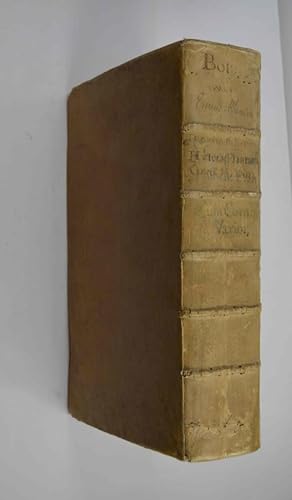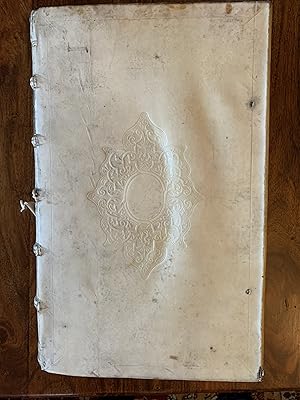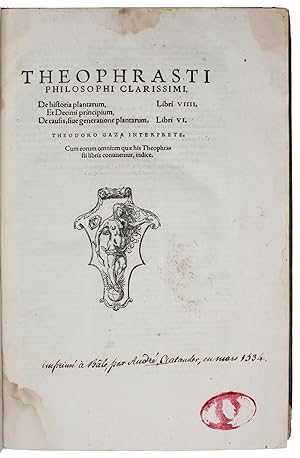historia plantarum von theophrastus (6 Ergebnisse)
Produktart
- Alle Produktarten
- Bücher (6)
- Magazine & Zeitschriften
- Comics
- Noten
- Kunst, Grafik & Poster
- Fotografien
- Karten
-
Manuskripte &
Papierantiquitäten
Zustand
- Alle
- Neu
- Antiquarisch/Gebraucht
Einband
Weitere Eigenschaften
- Erstausgabe (3)
- Signiert
- Schutzumschlag
- Angebotsfoto (5)
Land des Verkäufers
Verkäuferbewertung
-
Théophraste. Recherches sur les plantes [Historia plantarum, griech. u. franz.]. Texte établi et traduit par Suzanne Amigues. T. 1-5 [vollständig].
Verlag: Les Belles Lettres, Paris, 1988
Anbieter: Michael Fehlauer - Antiquariat, Muenster, Deutschland
8°. 1988-2006. (Collection des Universités de France - Budé.). Gelblicher OPBd (Vol. 4 u. 5: OKt) mit Rücken- u. Deckeltitel, Fadenh.; 2115 gr. Sprache: Französisch, T. 1: Livres I-II. 1988. LVIII S., 66 Doppels., S. 68-143. T. 2: Livres III-IV. 1989. 118 Doppels., S. 120-304. ISBN: 2-251-00404-5; T. 3: Livres V-VI. 1993. XII S., 54 Doppels., S. 58-210. ISBN: 2-251-00437-8; T. 4: Livres VII-VIII. 2003. XII S., 72 Doppels., S. 74-236; T. 5: Livre IX. 2006. LXX S., 60 Doppels., S. 62-397. ISBN: 2-251-00529-3.-- Fünf sehr gut erhaltene Exemplare, Band 4 u. 5 in der kartonierten Ausgabe. 2300 Gramm.
-
De historia plantarum libri decem. Graece & latine. In quibus textum graecum variis lectionibus, emendationibus, hiulcorum supplementis. Latinam Gaza versionem nova interpretatione ad margines&
Verlag: apud Henricum Laurentium,, Amstelodami,, 1644
Anbieter: Studio Bibliografico Benacense, Riva del garda, Italien
Cm. 37, pp. (20) 1187 (89). Bel frontespizio interamente figurato e centinaia di incisioni xilografiche nel testo raffiguranti varietà di piante e fiori. Solida legatura strettamente coeva in pergamena rigida, dorso a nervi con titoli manoscritti. Qualche naturale brunitura al alcune carte, ma esemplare molto genuino, marginoso ed in ottimo stato di conservazione. Stimata e celebre edizione che presenta il testo latino e greco di questo classico considerato più importante dal punto di vista scientifico-botanico che filologico. Cfr. Nissen, Pritzel, e Choulant.
-
Berlin; Weidmannsche Buchhandling, 1934. 24x16 cm. 75-105 pp. Original printed wrappers, stapled. A rift at head of spine. Wrappers and fore-edge are slightly foxed. From the library of the Swedish professor of Greek Albert Wifstrand (1901-1964).
-
De Historia plantarum libri decem.
Verlag: Amsterdam: Hendrick Laurensz, 1644
Anbieter: Symonds Rare Books Ltd, London, Vereinigtes Königreich
Buch Erstausgabe
Hardcover. Zustand: Very Good. 1st Edition. FIRST EDITION edited by Joannes Bodaeus à Stapel. Folio (37 x 23 cm); 1187 pp. plus index un-paginated; double column, text in parallel Greek and Latin. With fine engraved pictorial title; numerous woodcut botanical illustrations in the text; woodcut decorative initials. Small wormhole trace at foot of first few ff., diminishing in size as proceeds; minor wormholes to upper margins on last few ff. Small tear at 3H5 within text, without loss. Contemporary vellum; spine in compartments and with later gilt filets, small black floral motifs and a green morocco label, inconspicuous restoration; covers with blind-stamped arabesque centre-pieces, lacking ties, and showing signs of cracking in joints on lower, upper cover, little stained and marked. An excellent copy. As described by Hunt, this is one of the best and most thoughtfully prepared of all the editions of Theophrastus. It is interesting not only because of the brilliance of the editing, but, curiously enough, to the American botanist as well, for involving in the discussion certain species from Virginia, other parts of the New World, and Asia. The illustrations of these plants have been largely overlooked in botanical history, because of their incidental presence in a work which might not be expected to contain anything of the sort. Some were merely borrowed from l Ecluse or de Lobel, but others seem original in this work. (H.H. Bartlett in Fifty-five Rare Books, quoted by Hunt). Richly illustrated edition in excellent condition. Hunt 240.
-
Amsterdam, Heinric Laurentius, 1644. Folio. Contemporary full vellum with neat later (19th century) rebacking. Six raised bands and gilt title to spine. Some wear to extremities. Internally a fresh and clean copy with only a bit of occasional brownspotting. Endpapers with a bit of soiling. 2 bookplates to inside of front board: Gilbert Redgrave, London (dated 1894) & Gorden M. Jones, Virginia. Text in Greek and Latin. Woodcut title-page, numerous woodcut intials throughout, and more than 600 woodcut illustrations in the text. (20), 1187, (1), (88 - Index) pp. First edition thus, being the most important and influential edition of Theophrastus' seminal work "Enquiry into Plants" - the first systematization of the botanical world and the most important contribution to botanical science up until the Renaissance. Bodaeus von Stapel's groundbreaking edition constitutes the first illustrated edition of Theophrastus' masterpiece as well as the first with both Greek and Latin text. Furthermore, von Stapel has not only collected all relevant commentaries and knowledge, he has also added corrections and much foundational information, turning the work into one of the most influential botanical works of the 17th century, profoundly influencing the likes of Linnaeus and contributing significantly to the development of modern scientific botany. "This edition displays great care and research" the notes are numerous and learned, and all botanical information to be gleaned from Aristotle, Pliny, Dioscorides, and other ancient writers, seems to be embodied in this work. The Greek text is Heinsius's" the Latin version is that of the editor, who has placed Gaza's in the margin, with frequent corrections. The conjectures of Scaliger, Constantine, and Salmasius, are also incorporated. it has collected into one body the opinions of the old writers on the subject of the PLANTS. It contains some wood-cuts of the rarer species, which are much better uncoloured than coloured." Dibdin II:498). The numerous woodcut plant illustrations were partly copied from other sources and partly made especially for this edition. Thus, apart from being "one of the best and most thoughtfully prepared of all the editions of Theophrastos" (Hunt), our editor has also made original contributions that are of great importance. "It is interesting not only because of the brilliance of the editing, but, curiously enough, to the American botanist as well, for involving in the discussion certain species from Virginia, other parts of the New World, and Asia. The illustrations of these plants have been largely overlooked in botanical history, because of their incidental presence in a work which might not be expected to contain anything of the sort. Some were merely borrowed from l'Ecluse or de Lobel, but others seem original in this work" (H.H. Bartlett: Fifty-five Rare Books - quoted by Hunt).At the height of the Renaissance, with the expansion of the known world and the spreading of the book due to the invention of the printing press, many new publications on plants appeared. Most of these publications, however, were primarily concerned with the medicinal qualities of individual plants and only few authors or editors took an interest in the general nature of the plants and how they could systematically be classified. One of the few exceptions was Bodaeus von Stapel. With his seminal 1644 edition of "Historia Plantarum", he focused on the overarching classification system of plants and took Theophrastus' work a step further, adding essential commentaries and illustrations - illustrations that were to be copied for centuries after. These illustrations remain the standard illustrations of Theophrastus' foundational work. This edition of Theophrastus' "Historia Plantarum" became the standard edition of that earliest work on systematic botany and the edition that all serious scientific botanists of the 17th and 18th centuries will have studied. "Linnaeus, in the practice of his favourite art of systematizing, classified not only plants but the writers about them. The writers he distinguishes primarily as Botanists, and Plant Lovers, recognizing as Botanists only such as treat of plants from some philosophic or scientific point of view. Choosing his illustrations from annals of remote antiquity, he names among the earliest of the Greeks who wrote of plants Hippocrates" but because he wrote of plants only in the interests of medicine Linnaeus styles him Father of Medicine. Similarly Aristotle. is down in the Linnaean list of ancient celebrities as Prince of Philosophers. To Theophrastus, however, he accords the title Father of Botany. From this opinion, far from having been newly promulgated in Linnaeus's time, there has been no dissenting voice. On the contrary, Albert Haller, one of the most learned men in Europe in his day, and a botanist of such renown that Linnaeus held him in reverence, and also in some fear, denominates Theophrastus "the first of real botanists in point of time." Kurt Sprengel in the nineteenth century, having rehearsed the names of a long line of ancient authors who had written more or less concerning plants, says: "But the most illustrious of them all, and the true father of botany, was Theophrastus Eresius?." (Greene, Landmarks of Botanical History, I:128).It is no wonder that Linnaeus should find in Theophrastus the Father of his own field - The "Historia Plantarum" was not only the earliest work on systematic botany, it also contained Theophrastus' description of the formation of the plant seed, the earliest account known and the best that was made for 2000 years.Hunt: 240" Pritzel: 9197 BM: V:2091 Dibdin: II:498.
-
(Colophon: Basel, apud Andream Cratandrum, 1534). Folio. Nice hcalf from ab. 1750, richly gilt back, gilt title-label. Corners a bit bumped. Slightly rubbed. Woodcut printer's device to title and last leaf. (28),264,(2) pp. With many smaller and larger woodcut initials. Small stamp at lower corner of the first 2 leaves. Some, rather faint, dampstainings to first and last leaves, otherwise clean and with broad margins. Engraved book-plate inside front board (Bibliotheque du comte Le Moyne de Martigny). Very scarce edition of Theophrastus' two main works. It is one of the earliest Latin editions of Gaza's esteemed translation, in reality it is the third printing of the first Latin edition (first issued 1483, then 1529 in 8vo, and now 1534) of the works which together constitute the foundation of scientific botany. By Linnaeus Theophrastus is called "the father of Botany". This edition comprises both botanical works, The History of Plants and The Causes of Plants, which have survived in their entirety and are the earliest books of this kind in world literature."It is very strange that so much botanic knowledge should have been accumulated by the end of the fourth century and that so little, if anything, was added to it in ancient times. Theophrastos is not only the first botanic writer but also the greatest until Renaissance of the sixteenth century in Germany.The botany of Theophrastos and the zoölogy of Aristotle represents the climax of natural history in antiquity." (Sarton in A History.Vol. I p. 558). "No study of plants of such breadth and quality had previously been conceived: botany now first appears as a distinct science with a comprehensive yet clearly defined field of enquiry." (A.G. Morton). - Stillwell No. 702 (Note) - Hunt No. 26 (listing the 1529-edition in 8vo) - Pritzel: 9189. - Not in Choulant, Handbuch der Bücherkunde für die Ältere Medicin.


![Bild des Verkäufers für Théophraste. Recherches sur les plantes [Historia plantarum, griech. u. franz.]. Texte établi et traduit par Suzanne Amigues. T. 1-5 [vollständig]. zum Verkauf von Michael Fehlauer - Antiquariat](https://pictures.abebooks.com/inventory/md/md31453125628.jpg)



![Bild des Verkäufers für De historia plantarum libri decem. Graecè & Latinè. Textum Graecum variis Lectionibus, emendationibus, hiulcorum supplementis: Latinam Gazae versionem nova interpretatione ad margines: totum Opus absolutissimis cum Notis, tum Commentariis: item rario. - [THE MOST IMPORTANT BOTANICAL WORK OF THE 17TH CENTURY] zum Verkauf von Lynge & Søn ILAB-ABF](https://pictures.abebooks.com/inventory/md/md14930431564.jpg)
